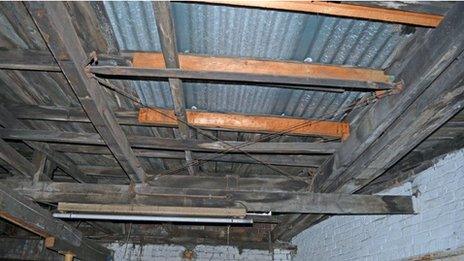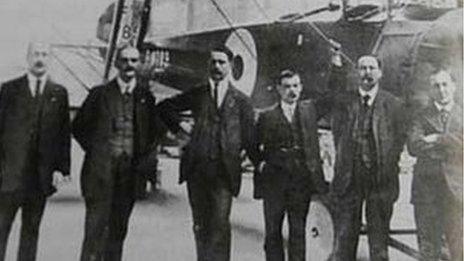WW1 bi-plane wings recovered from Connah's Quay garage roof
- Published

World War One bi-plane wing sections form part of the garage roof
Rare wooden wing sections from a World War One bi-plane have been saved after they were discovered propping up the roof of a garage in Flintshire.
The Handley Page O/400 bomber was found during work at the unit at Dock Road, Connah's Quay.
The site is near to the former RAF Sealand camp which was used as a WW1 flight training school.
RAF experts are sure the artefacts originally formed part of the lower wings of the historic aircraft.
But it is not known how the wings came to be in the former warehouse but there is speculation it could be connected to the nearby RAF Sealand site.
It became home in 1916 to a flying school which, during WW1, was requisitioned by the War Office becoming RAF Sealand in 1924, according to Clwyd-Powys Archaeological Trust.
Members of the Michael Beetham Conservation Centre at the RAF Museum Cosford in Shropshire, were first alerted to the existence of the wing parts in April.
They received an email suggesting the roof of a building due for demolition had been constructed using components from a World War Two Wellington bomber.

This photograph shows an early aeroplane with the founder of the RAF Sealand airfield, Tom Dutton, seen third right
But the museum's curatorial staff instantly recognised the wings were from a much earlier aircraft.
Garage owner Alan Sullivan then allowed them to remove the wing parts while the site was being cleared.
Senior curator Al McLean said: "A visit to the site revealed that these were wooden wings with a type of construction known as box spars.
"This suggested that the aircraft dated from the latter part of the First World War and given the size of them, there were only a few aircraft types they could have originated from.
"The Handley Page O/400 was the obvious candidate and after a brief look at a manual we were fairly positive that that was what we were looking at."
The wing sections, recovered last month, are now being stored at RAF Stafford, which already houses other remnants of the O/400, including panels and struts.
RAF Museum curator Ewen Cameron said: "The Handley Page O/400 is a vitally important aircraft in the history of the RAF.
"One of the main reasons the Royal Air Force was established in 1918 was so that it could operate as an independent arm of the military, capable of striking deep into the heart of enemy territory.
"It was largely the O/400 which offered the RAF this capability."
- Published25 November 2013
- Published21 November 2013
- Published20 November 2013